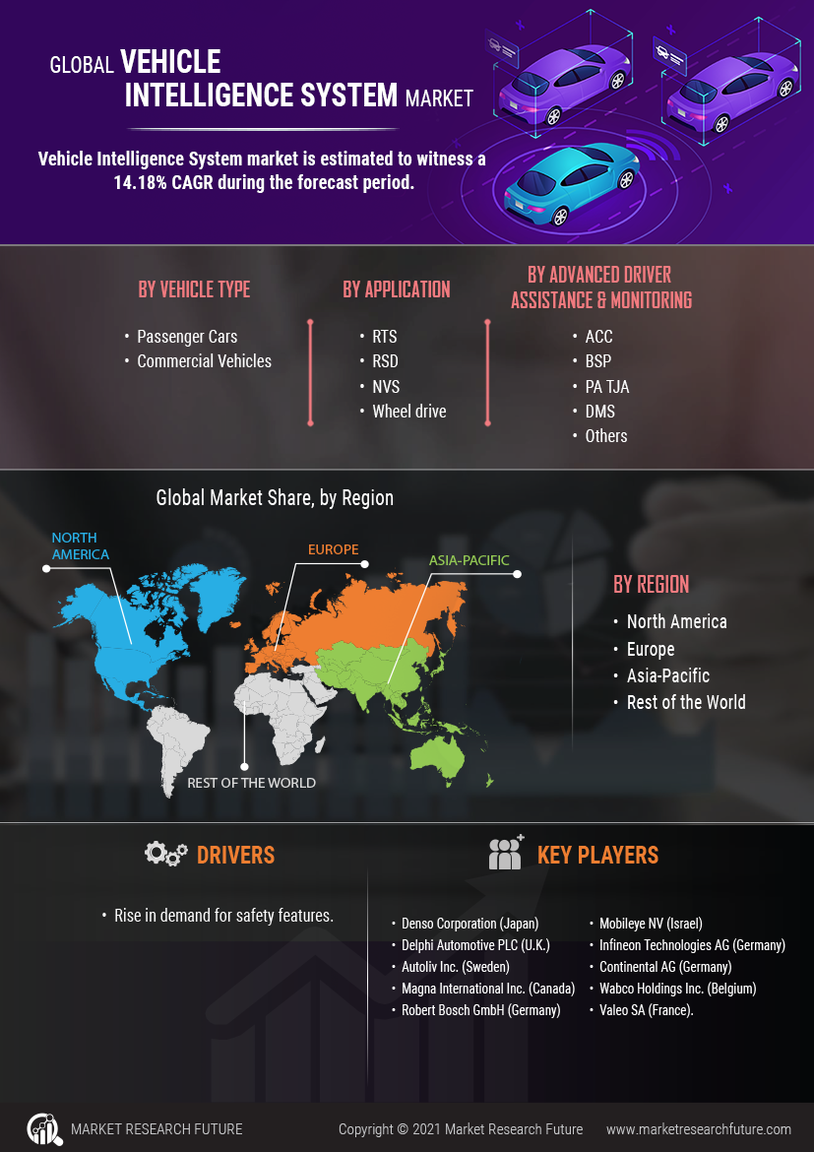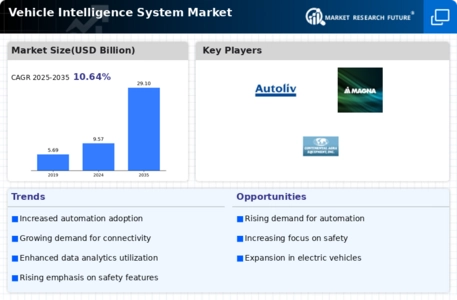Market Growth Projections
The Global Vehicle Intelligence System Market Industry is poised for substantial growth, with projections indicating a market value of 9.57 USD Billion in 2024 and an anticipated increase to 29.1 USD Billion by 2035. This growth trajectory suggests a compound annual growth rate of 10.65% from 2025 to 2035. Such figures highlight the increasing investment in vehicle intelligence systems driven by technological advancements, regulatory pressures, and consumer demand for enhanced safety and connectivity features. The market's expansion reflects broader trends in the automotive industry, where innovation and sustainability are becoming paramount.
Government Initiatives and Regulations
Government initiatives and regulations play a crucial role in shaping the Global Vehicle Intelligence System Market Industry. Many countries are implementing stringent regulations aimed at improving vehicle safety and reducing emissions. For instance, the European Union has introduced regulations mandating the inclusion of advanced driver-assistance systems in new vehicles. These regulations are likely to drive manufacturers to invest in vehicle intelligence systems, thereby fostering market growth. As a result, the industry is expected to witness a compound annual growth rate of 10.65% from 2025 to 2035, reflecting the increasing emphasis on safety and environmental sustainability.
Growing Adoption of Connected Vehicles
The growing adoption of connected vehicles significantly influences the Global Vehicle Intelligence System Market Industry. As vehicles become more interconnected, the demand for vehicle intelligence systems that facilitate communication between vehicles and infrastructure increases. Connected vehicles can share real-time data regarding traffic conditions, weather, and road hazards, enhancing overall safety and efficiency. This trend is evident in the rising number of smart city initiatives globally, which aim to integrate connected vehicles into urban environments. The market's expansion is expected to align with the projected growth trajectory, reaching 29.1 USD Billion by 2035, as more consumers embrace the benefits of connectivity.
Rising Demand for Advanced Safety Features
The Global Vehicle Intelligence System Market Industry experiences a notable surge in demand for advanced safety features. Consumers increasingly prioritize safety in vehicle purchases, prompting manufacturers to integrate sophisticated systems that enhance driver and passenger protection. For instance, features such as automatic emergency braking, lane-keeping assistance, and adaptive cruise control are becoming standard in many new models. This trend is reflected in the projected market value, which is expected to reach 9.57 USD Billion in 2024. As safety regulations tighten globally, the adoption of vehicle intelligence systems is likely to accelerate, driving growth in this sector.
Consumer Preference for Autonomous Driving Technologies
Consumer preference for autonomous driving technologies is a driving force in the Global Vehicle Intelligence System Market Industry. As public interest in self-driving vehicles grows, manufacturers are compelled to invest in advanced vehicle intelligence systems that support automation. This includes the development of sophisticated sensors, cameras, and software that enable vehicles to navigate without human intervention. The increasing acceptance of these technologies is likely to propel market growth, with the industry projected to achieve a value of 9.57 USD Billion in 2024. As advancements continue, the potential for fully autonomous vehicles may reshape consumer expectations and industry standards.
Integration of Artificial Intelligence and Machine Learning
The integration of artificial intelligence and machine learning technologies into vehicle intelligence systems is transforming the Global Vehicle Intelligence System Market Industry. These technologies enable vehicles to analyze vast amounts of data in real-time, enhancing decision-making processes and improving overall vehicle performance. For example, AI-driven systems can optimize route planning, reduce fuel consumption, and enhance predictive maintenance. As the market evolves, the incorporation of these technologies is expected to contribute significantly to the projected growth, with the market anticipated to expand to 29.1 USD Billion by 2035. This integration not only enhances user experience but also promotes sustainability in the automotive sector.













